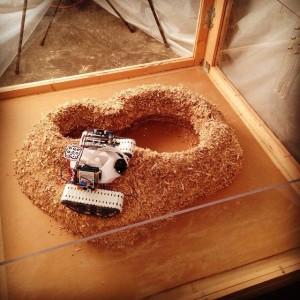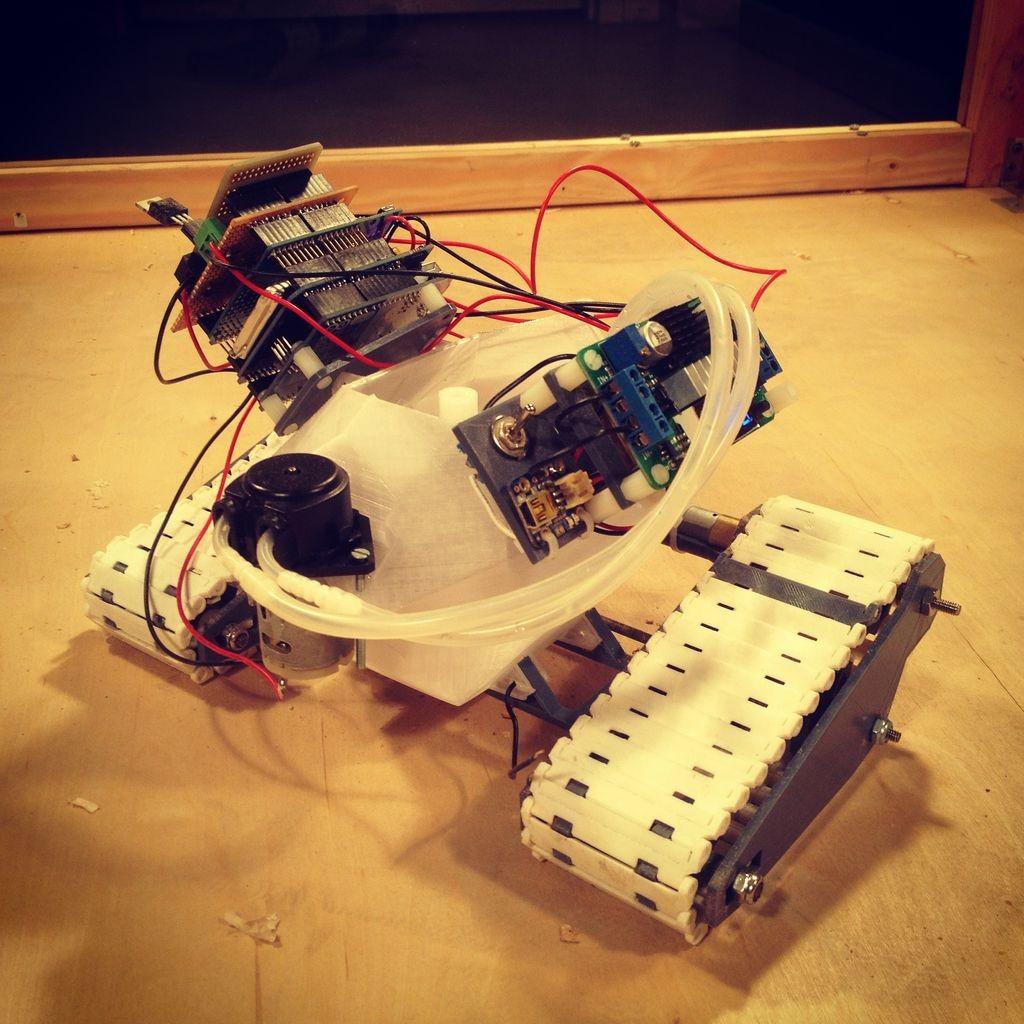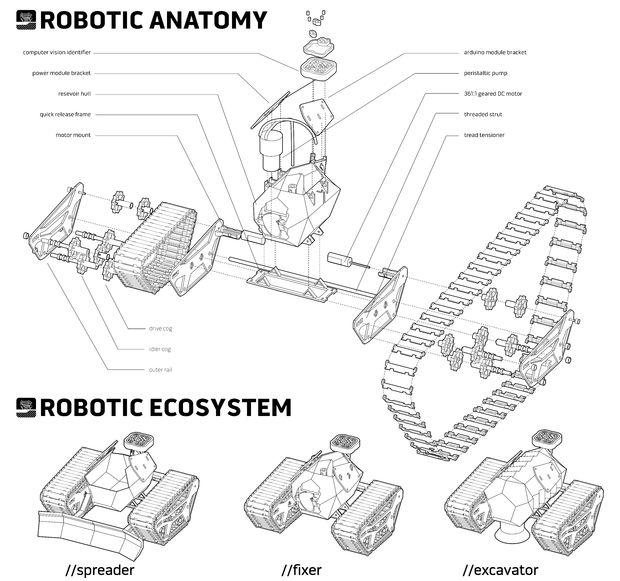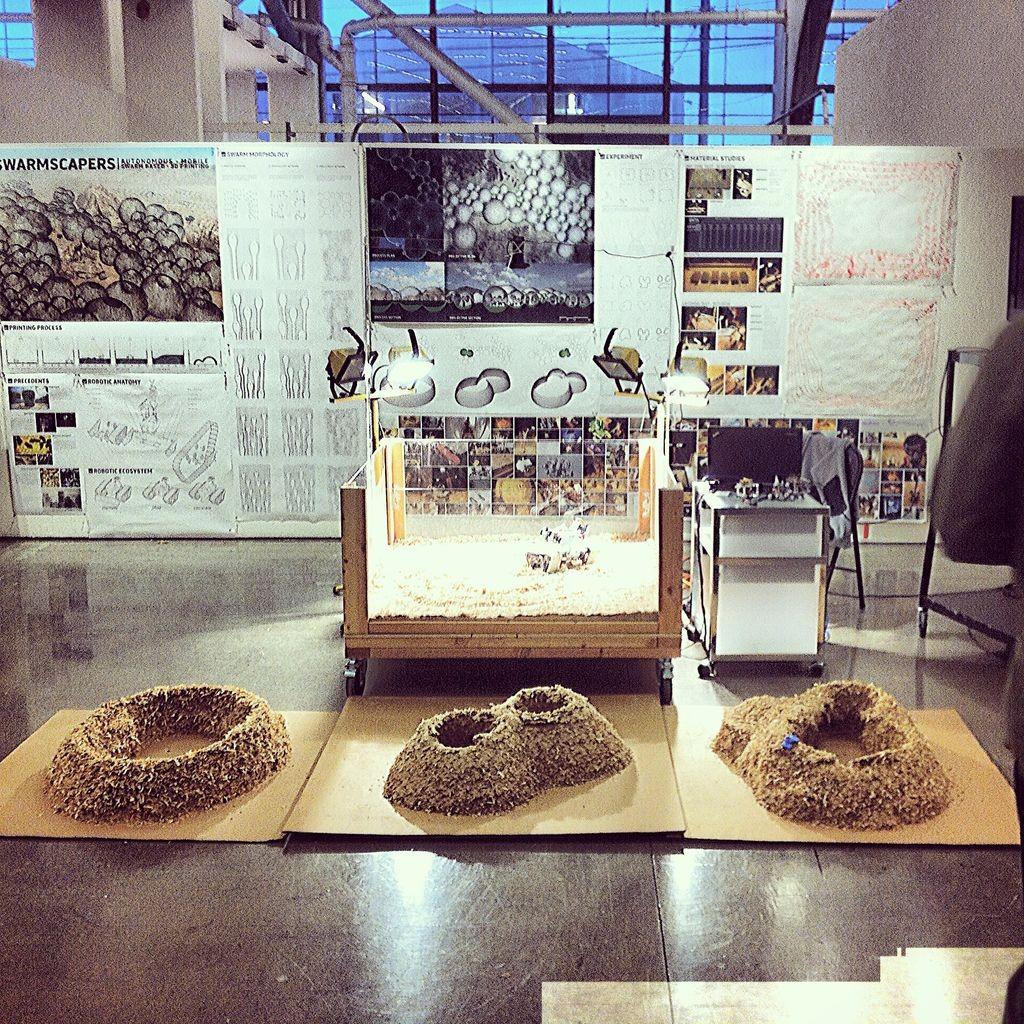 Imagine a reality of 3D printing robots, in a community unto themselves, diligently working in unpredictable temperatures and conditions, strong and steady — just taking care of business. Efficiently. Perfectly. Without complaint. This is what a group of student architects are perfecting with the Swarmscapers.
Imagine a reality of 3D printing robots, in a community unto themselves, diligently working in unpredictable temperatures and conditions, strong and steady — just taking care of business. Efficiently. Perfectly. Without complaint. This is what a group of student architects are perfecting with the Swarmscapers.
Imagine these silent machines excavating materials, compiling them, seamlessly 3D printing, and building a colony on Mars where humans could live indefinitely. Robots have all the time in the world. We could set them to work and go back to our business while they make a building, or an entire community on the moon. 3D printed robots creating 3D printed buildings: it’s the ultimate in a perfect cycle of sustainability.
 While progressing in robotics and finding ways to colonize space are both things listed on the big human “to do” list, they may be coming together as one of the quotients in answering how to complete building tasks in places we are quite simply unwelcome, and where colonization has previously been impossible.
While progressing in robotics and finding ways to colonize space are both things listed on the big human “to do” list, they may be coming together as one of the quotients in answering how to complete building tasks in places we are quite simply unwelcome, and where colonization has previously been impossible.
A project just completed in the Creative Architecture Machines studio at California College of the Arts in the Digital Craft Lab displays the architectural — and engineering — talents of student architects Clayton Muhleman, Alan Cation, and Adithi Satish. While they are not expected to be engineers, the point of the project was that they, as architects, be responsible in a building project from A to Z. That included making their tools for building as well. In answer to the question regarding how they did in creating their own technological tools rather than just relying on ready-made templates supplied by engineers, the students were able indeed to fill in the gaps in a superior manner that exhibited innovation which may be very useful. The biggest question left here is when NASA will come calling.
Exploring the concept of robots working on their own to build in areas found to less than hospitable for human life, the idea is that with the use of 3D printing the robots would use local materials (say, moon dust) as material for a 3D printer, and then work steadily to create buildings. With a “swarm” of robots, they would work in a team not unlike a factory setting, with each robot responsible for one task.
Muhleman, Cation, and Satish have provided their files for building the experimental work in an Instructable. It’s as simple as needing a robot that 3D prints.
 The architects 3D printed the parts they designed for the robots, right down to the cogs for the wheels. The chassis and frame had to be assembled using a number of metal parts, washers, and nuts. See here. Aluminum sleeves and zip ties were used to complete the project. For electronics, there were two stacks. The first was composed of a 7-volt power nodule using:
The architects 3D printed the parts they designed for the robots, right down to the cogs for the wheels. The chassis and frame had to be assembled using a number of metal parts, washers, and nuts. See here. Aluminum sleeves and zip ties were used to complete the project. For electronics, there were two stacks. The first was composed of a 7-volt power nodule using:
- Adafruit LiPo chargers
- 2000 maH LiPo batteries
- One DC Voltage converter
The second was composed of:
- One Arduino Uno
- Adafruit battery shield and LiPo battery
- Two X-Bee Series 1’s
- An X-Bee shield
- X-Bee USB adapter
- H-bridge motor controller
- Mosfet transistor to control the peristaltic pump
For the wiring of the robot, the power and shield stacks are assembled and then the students suggest you “run the higher voltage power to the pump circuit and into the correct pin on your H-Bridge shield.” They leave interested users out there with the reminder that there are many different tutorials online for figuring some of the more complex parts of the wiring. They do remind makers, however, that this robot needs to be able to back forward and backward.
 For the list of software the architects used for modeling and programming, from Rhino to Arduino, click here. Once all the software and plug-ins are installed, you need to make sure programming is completed so the robots are capable of doing their jobs, which is, essentially, moving from point A to point B and layering the binding agent. For setting up wireless so that there is communication between the software and the Swarmscaper, check out the their instructions, as well as the additional links they offer for getting up to speed in this area.
For the list of software the architects used for modeling and programming, from Rhino to Arduino, click here. Once all the software and plug-ins are installed, you need to make sure programming is completed so the robots are capable of doing their jobs, which is, essentially, moving from point A to point B and layering the binding agent. For setting up wireless so that there is communication between the software and the Swarmscaper, check out the their instructions, as well as the additional links they offer for getting up to speed in this area.
Once you’ve made a trip to the lumber yard for the list of materials necessary, you are ready to set up the printer bed, with a reminder that you will need a supply for the binding agent, as well as a webcam.
One important point in the print bed that the architects used was in overbuilding so that if they had to load a ton of sand into it at some point, they had the capacity built in. See here for an explanation of how the pieces fit together.
Binding agents such as sand, sawdust, or anything granular are suggested. While sand would work, the architects used sawdust as it was more efficient overall. It’s important to note that there are multiple binding agents that could work and further experimentation is definitely necessary.
Using an enclosure for the 3D printing area, as well as protective masks, the architects set out to start 3D printing. They laid out and smoothed, and compressed the sawdust. That has to be repeated with each layer. Halogen lights are turned on, which provides heat and helps overall.
With the glue loaded in the robot’s hopper, once the ‘on’ switch is flipped, you can watch it travel from point to point until it finishes and switches off. The architects waited until their object dried and then vacuumed all the excess dust from it.
As with the last article I wrote recently regarding student architects who produced a two-month project for this same class with a clay 3D printer featuring cable suspension, the results and implications for further uses are enormous, opening up many ideas for printing in inhospitable areas. The swarm of 3D printing robots works on a small scale, as tested, so the next step is in testing it on a larger scale while experimenting with different materials and binding and agents.
Both robots and 3D printing are synonymous with repetitive work, so combining them to complete one major project we are incapable of handling physically is logical. That computes.
Are you involved in any 3D printing of robotics? What do you think of the concept of robots colonizing space or another outpost with 3D printing? Tell us about it in the Swarmscapers forum over at 3DPB.com.
Subscribe to Our Email Newsletter
Stay up-to-date on all the latest news from the 3D printing industry and receive information and offers from third party vendors.
Print Services
Upload your 3D Models and get them printed quickly and efficiently.
You May Also Like
3D Printing News Briefs, July 2, 2025: Copper Alloys, Defense Manufacturing, & More
We’re starting off with metals in today’s 3D Printing News Briefs, as Farsoon has unveiled a large-scale AM solution for copper alloys, and Meltio used its wire-laser metal solution to...
Etsy Design Rule Change Reduces Selection of 3D Printed Goods
Online marketplace Etsy has implemented a rule change requiring all 3D printed goods on the site to be original designs. The update to the site’s Creativity Standards states, ¨Items produced using...
Siraya Tech Introduces New Elastomer 3D Printing Materials, Including Foaming TPU
California company Siraya Tech, founded in 2019 with a focus on material science, customer focus, and agility, develops high-quality 3D printing materials that meet the needs of creators, hobbyists, and...
3D Printing News Briefs, April 12, 2025: RAPID Roundup
The news from last week’s RAPID+TCT in Detroit just keeps on coming! That’s why today’s 3D Printing News Briefs is another RAPID Roundup of more exciting announcements from the trade...





































